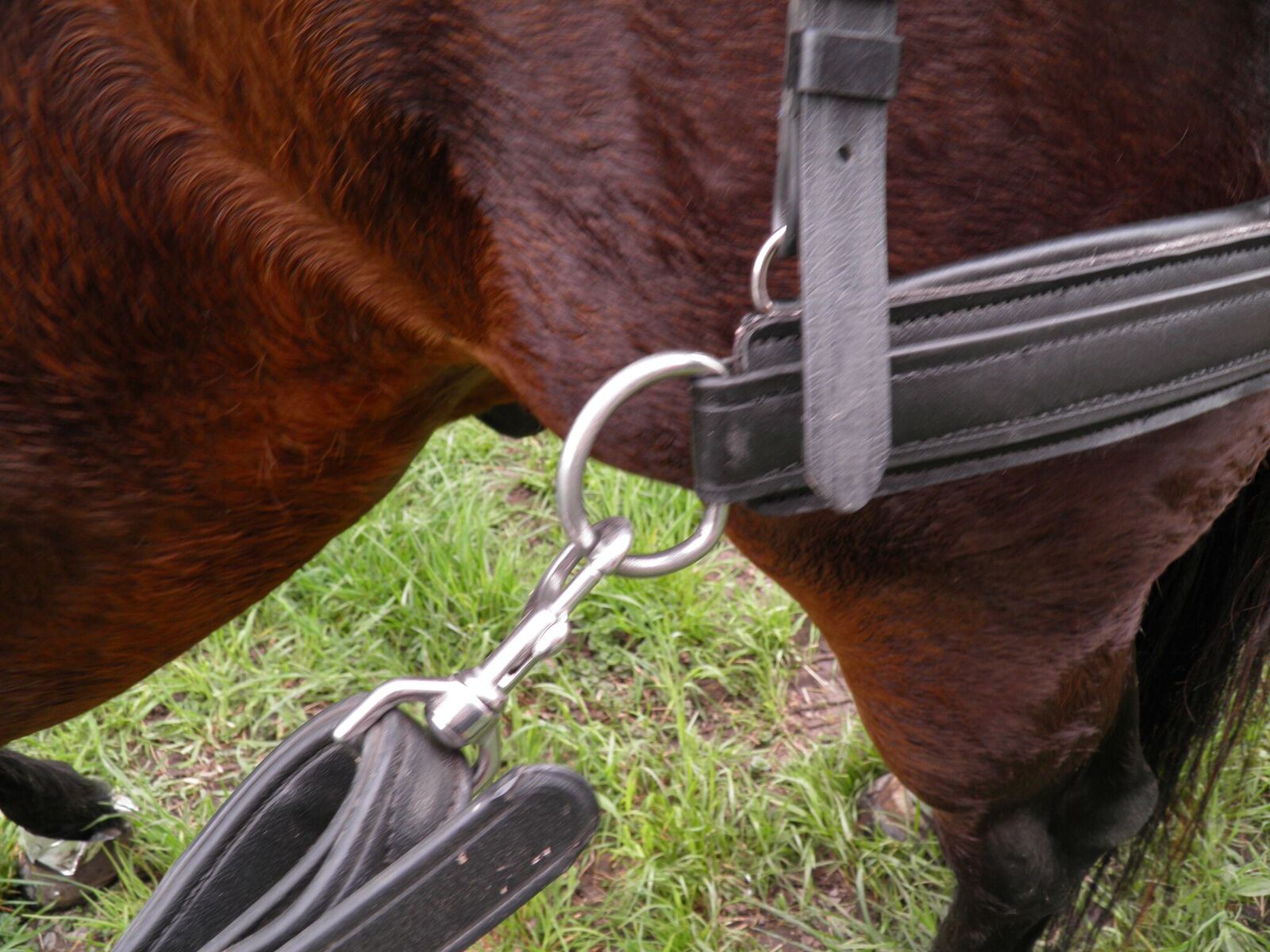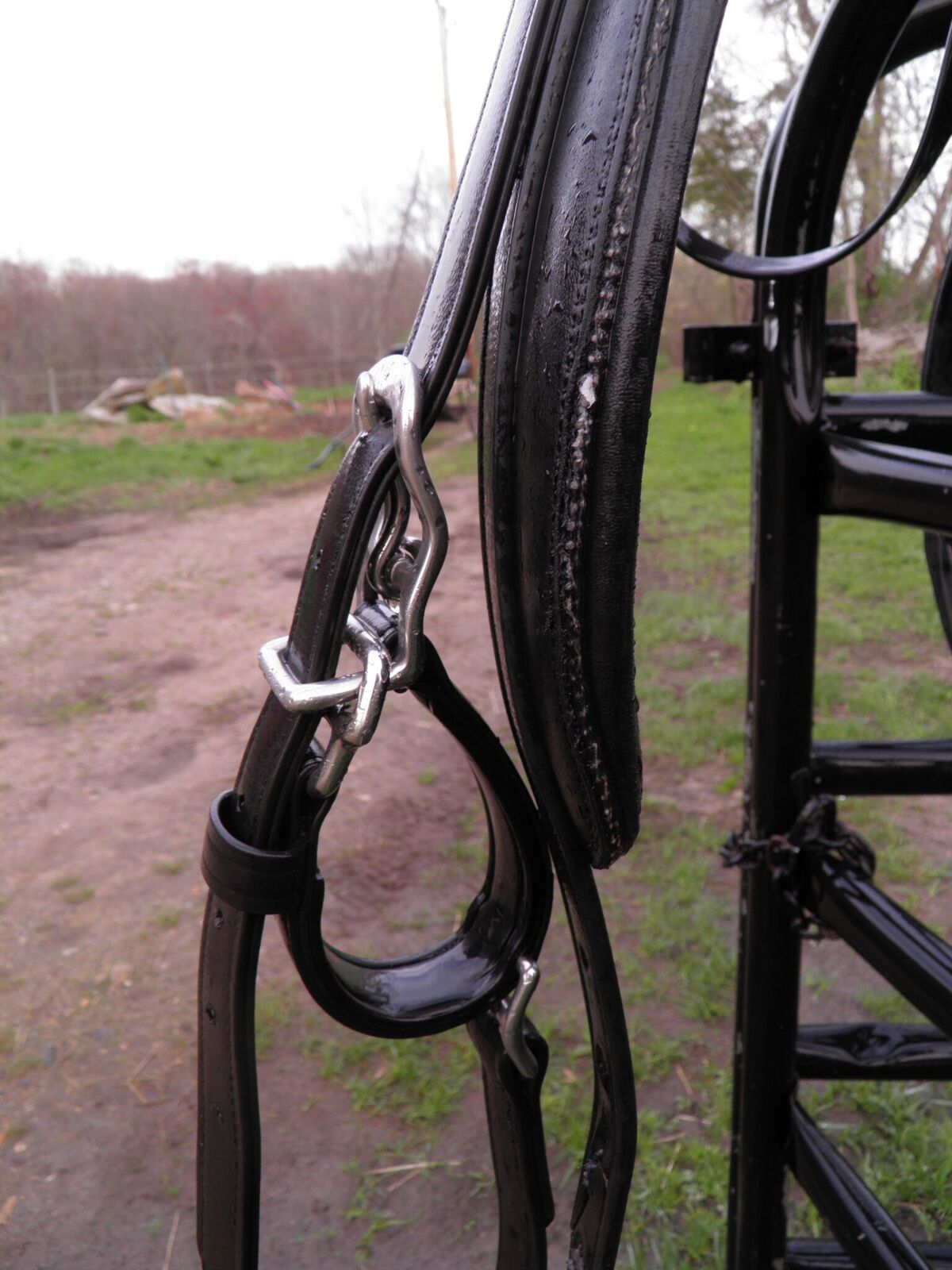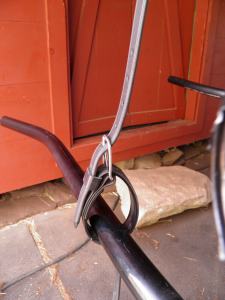Life After Racing
Tug of War
Quick-release hardware saves time
Standardbreds are consistently showing their versatility, whether it’s riding or driving, for show or for pleasure. Hoof Beats is happy to share stories from readers about their favorite Standardbreds. This month, Charlotte Gelston writes about how quick-release hardware can be convenient and safe—if rigged properly.

The quick-release snap allows for more expedient hitching and unhitching because of the way it attaches the breeching strap (which attaches to the cart shaft, not visible in this photo) to the breeching. Before the invention of this snap, the breeching strap was fed directly through the dee, a time-consuming step. Photo by the author.
Twenty-seven years ago, when I started pleasure driving my harness horse, I had never heard of “quick-release hardware.” Each time I would hitch my horse, I had to feed the breeching strap through the footman’s loop (also called the breeching dee), wrap it three times around the shaft, then pass the end under the first wrap and buckle it back on itself.
This was a tedious procedure, to say the least.
The trace would pass through the breeching strap under the buckle between the two halves of the breeching strap, where it entered and exited the footman’s loop on the underside of the strap.
One of my friends–who was a rider, but not a driver–said, “I would hate to have to go through all that to hitch a horse. It is much faster to just saddle them up.” I had to agree that harnessing and hitching was more time-consuming than saddling, but so worth it. If you are fortunate enough to have a Standardbred, driving adds another dimension to your equine activities.
Later on I discovered a wonderful little invention called the “quick-release snap.” I immediately bought two of them and attached the breeching straps to the new snap instead of running them through the dee ring at the front of the breeching. This allows you to leave the wrapped breeching strap attached to the shaft, instead of to the breeching itself. You simply clip it onto the breeching when you hitch. It is a great time-saver, but it is also a safety feature. In case of an emergency, it takes less time to unhitch your horse when seconds can count.
A few years ago I heard about the quick-release tug, but had never seen one. When a friend gave me set of them as a thank-you gift, I was thrilled. I couldn’t wait to try them out. Having been in a situation where having quick-release tugs would have made a huge difference in freeing a downed horse, I knew their value in an emergency (see the article titled “When the Worst Happens” in the June 2015 issue).
It is much easier to disconnect the quick-release tugs because you do not have to undo the buckle holding the tug to the tug strap; you just bring the other end of the strap back through the keeper and the two halves open quickly. The pressure from above on the buckle remains, but the tug opens below the buckle where there is much less pressure.
By coming apart, rather than staying an enclosed loop, the shaft is immediately free of the harness. With a conventional tug, the loop does not separate, so you must push the shaft backward through it to remove the tug from the shaft, or disconnect both the upper and lower buckles on the tug, freeing it from the harness, but staying in place on the shaft. This is not an easy thing to do in a hurry, or with a horse down!
As I changed out my regular tugs for the new ones, I found the tug straps on my harness were not quite long enough to go all the way through the keeper. Ever the optimist, I thought to myself, “This will be OK for one time.” With the weight of the shaft in the tug, it would take a lot of pressure to lift the strap up and out of the keeper, which releases the hardware holding the two pieces of the tug in place.
Or so I thought.
“Rhythm,” registered as Mr Artline, and I headed out for a nice drive. We cantered up the hill at the end of the dirt road, as usual. As we turned left on the paved road to do the “five-mile loop,” I suddenly saw that my left shaft was swinging loose, no longer connected to the tug!
Luckily, Rhythm remained calm. I reined him over to the side of the road, asked him to “whoa” and “stand,” and got out of the cart. I knew he could be trusted to stand like a statue while I solve the problem.
It was a struggle to get the two pieces of the tug threaded back together with the pressure of the shaft. I had to put my shoulder under the shaft, lifting it to lessen the 10 lbs. of pressure so I could get the strap back through the metal bracket and then the keeper.
Rhythm was watching me closely the entire time. Since I drive him open and bitless, he could see me and stay focused on what I was doing. He did not move at all as I tried to muscle the tug back into the correct configuration. He may be a strong-willed, expressive and dominant horse, but he has never disappointed me in a tough situation.

Freeing the shaft from the harness becomes easier with a quick-release tug.

Its buckle arrangement allows the loop to part into two halves.

In comparison, the loop of a conventional tug does not separate, which means one must either push the shaft backward through the tug to free the harness from the shaft, or disconnect the tug’s two buckles to free it from the harness but allow it to remain in place on the shaft–both time-consuming steps. Photos by the author.
I realized that the up and down motion of his cantering had been enough to dislodge the strap, because it was not all the way through the keeper. It is said we learn best from our mistakes, and I heartily agree.
If I had thought it through more carefully, I might have been aware that it was not a good idea to use the new tugs with my short tug straps. Also, I should not have cantered up the hill, because the motion caused the release of the strap. I can assure you I did not canter again the rest of the way home. We returned without further incident.
After turning Rhythm out to pasture, the first thing I did was call Yonie’s Harness Shop to order tug straps four inches longer than the ones I had on my harness. With all the cantering up hills, jumping over puddles and logs, bouncing over tree roots and rocks, we have never managed to dislodge those wonderful quick-release tugs again, thanks to the proper setup I now have.
To see more from the September 2017 issue of Hoof Beats, click here.
